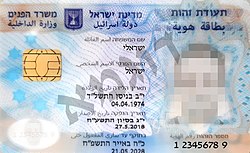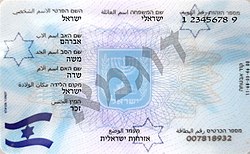| Teudat Zehut תעודת זהות بطاقة هوية | |
|---|---|
 The front side of a contemporary biometric Israeli identity card | |
 The reverse side of a contemporary biometric Israeli identity card | |
| Type | National identity card |
| Issued by | |
| First issued | 1948 2013 (Biometric) |
| Purpose | Identification |
| Eligibility | 16 years of age All Israeli citizens, legal permanent or temporary residence status (including non-citizens) |
| Expiration | 10 years after acquisition. Or, in the case of non-biometric identity cards, the expiration date is no later than August 2024. The expiration dates of identity cards issued to foreign nationals is linked to the validity of their visa. |
| Cost | Free or ₪130 to replace a lost identity card.[1] |
Teudat Zehut (Hebrew: תעודת זהות t'udát zehút) or Huwiyyah (Arabic: بطاقة هوية biṭāqat huwiyyah) is the Israeli compulsory identity document issued by the Ministry of Interior, as prescribed in the Identity Card Carrying and Displaying Act of 1982: "Any resident sixteen years of age or older must at all times carry an Identity card, and present it upon demand to a senior police officer, head of Municipal or Regional Authority, or a policeman or member of the Armed forces on duty."[2] According to a precedent from 2011, residents are entitled to refuse presenting the card, unless the state-official has a reason to suspect that they have committed an offence.[3]
Identity documents are issued by the Israeli government to Palestinians in East Jerusalem, the West Bank and the Gaza Strip, although these differ from those issued to Israeli citizens. Such documents are used to monitor and control the Palestinian population.[4][5]
- ^ "Issue of ID card". 22 September 2023.
- ^ חוק החזקת תעודת זהות והצגתה (Identity Card Carrying and Displaying Law of 1982) on the Hebrew Wikisource.
- ^ Court: There is no Obligation to Present an Identity Card upon a Policeman's Request, by Revital Hovel, Haaretz, 5 Dec 2011 (in Hebrew).
- ^ Abu-Zahra & Kay 2012, pp. 3–4: "If this book were to be translated to Arabic or Hebrew, it would probably have the simple title, "A History of the IDs", because of the weight of local meaning carried by the word "ID" (hawiyya in Arabic, or teudat in Hebrew)… For Palestinians in the West Bank and Gaza Strip, and before them, for Palestinians displaced within the 1949 Armistice lines, the ID was an instrument of suppression, repression, and humiliation. It was a denial of rights and the condition on which these rights were temporarily restored at the whim of Israeli authorities. The power of Darwish's poem is in the vivid explanation of all that the ID represents: population registration, denationalisation, and the stripping of all rights from the citizens of Palestine; a permit regime that makes all such rights subservient to Israeli state permission; the indignity of repeated ID checks in one's home, land, and movements from place to place; and the patient, split attitude toward the ID - acceptance of reliance on it, but rejection of its authority - until an opportunity arises to restore one's full rights. Remarkably, although the separated pieces of the puzzle have all been painstakingly chronicled, and while this multifaceted history of movement restriction, identity documentation, and population registration and denationalisation is recognised as being the crux of the Palestinian problem, no single book-length document seems to draw the line from one phenomenon to the other in a continuous sweep."
- ^ Gordon 2008, pp. 33–40: "The permit regime functioned simultaneously as the scaffolding for many other forms of control and thus as part of the infrastructure of control, as well as a controlling apparatus in its own right."